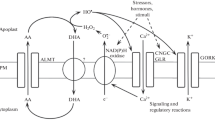Summary
We report that ascorbate free radical stimulates onion root growth at 15 °C and 25 °C. The fully reduced form, ascorbate, also stimulates root elongation if culture conditions allow its oxidation. When ascorbate oxidation was inhibited, no stimulation of root growth was found. The effect of the fully oxidized form, dehydroascorbate, was inhibitory. We show also that ascorbate free radical generated by ascorbate oxidation, is reduced back probably by a transplasmalemma reductase. These results are discussed on the basis of an activation of a transplasma membrane redox system likely involved in processes related to cell growth.
Similar content being viewed by others
Abbreviations
- AFR:
-
ascorbate free radical
- ASC:
-
ascorbate
- DHA:
-
dehydroascorbate
References
Alcaín FJ, Burón MI, Rodríguez-Aguilera JC, Villalba JM, Navas P (1990) Ascorbate free radical stimulates the growth of a human promyelocytic leukemia cell line. Cancer Res 50. 5887–5891
— —, Villalba JM, Navas P (1991) Ascorbate is regenerated by HL-60 cells through the transplasmalemma redox system. Biochim Biophys Acta 1073: 380–385
Arrigoni O, De Gara L, Tommasi F, Liso R (1992) Changes in the ascorbate system during seed development ofVicia faba L. Plant Physiol 99: 235–238
Bóttger M, Crane FL, Barr R (1991) Physiological aspects of transplasma membrane electron transport in roots and cultured carrot cells. In: Crane FL, Morré DL, Löw H (eds) Oxido-reduction at the plasma membrane. Relation to growth and transport, vol. III. CRC Press, Boca Raton, pp 207–236
Breckle SW (1991) Root growth under stress: heavy metals. In: Waisel I, Eshel A, Kafkafi U (eds) Plant roots. The hidden half. Marcel Dekker, New York, pp 351–373
Cleland RE (1971) Cell wall extension. Annu Rev Plant Physiol 22: 197–222
Crane FL, Sun IL, Clark MG, Grebing C, Löw H (1985) Transplasmamembrane redox system in growth and development, Biochim Biophys Acta 811: 233–264
Goldenberg H, Grebing C, Löw H (1983) NADH-monodehydroascorbate reductase in human erythrocytes plasma membrane. Biochem Int 6: 1–10
González-Quevedo M, Alcaín FJ, González-Reyes JA, Burón MI, Navas P (1991) Growth patterns of the HL-60 human promyelocytic cell line stimulated by ascorbate free radical. Cancer J 4: 262–266
González-Reyes JA, Döring O, Navas P, Obst G, Böttger M (1992) The effects of ascorbate free radical on the energy state of the plasma membrane of onion (Allium cepa L.) root cells: alteration of K+ efflux by ascorbate? Biochim Biophys Acta 1098: 177–183
—, Hidalgo A, Caler JA, Palos R, Navas P (1994) Nutrient uptake changes in ascorbate free radical-stimulated onion roots. Plant Physiol 104: 271–276
Hidalgo A, García-Hedugo G, González-Reyes JA, Morré DJ, Navas P (1991) Ascorbate free radical stimulates onion root growth by increasing cell elongation. Bot Gaz 152: 282–288
—, González-Reyes JA, Navas P (1989) Ascorbate free radical enhances vacuolization in onion root meristems. Plant Cell Environ 12: 455–460
Iyanagi I, Yamazaki J, Anan KF (1985) One-electron oxidation-reduction properties of ascorbic acid. Biochim Biophys Acta 806: 255–261
Lukaszewski MK, Blevins DG (1993) Ascorbate prevents root growth inhibition in boron-deficient and aluminium-stressed squash plants. Plant Physiol 102 [Suppl]: 164
Luster DG, Buckhout TJ (1988) Multiple electron transport activities in plasma membrane from maize (Zea mays) roots. Physiol Plant 73: 339–347
Lüthje S, Böttger M (1989) Hexabromoiridate IV as an electron acceptor: comparison with hexachloroiridate IV and hexacyanoferrate III. Biochim Biophys Acta 977: 335–340
Mertz D (1961) Ascorbic acid oxidase in cell growth. Plant Physiol 39: 398–401
Morré DJ, Navas P, Penel C, Castillo FJ (1986) Auxin-stimulated NADH oxidase (semidehydroascorbate reductase) of soy bean plasma membrane: role in acidification. Protoplasma 133: 195–197
Navarro F, Rodríguez-Aguilera JC, Alcaín FJ, Burón MI, Navas P (1992) Ascorbate potentiates serum-induced S phase entry of quiescent 3T3 cells. Protoplasma 169: 85–87
Serrano A, Villalba JM, Gonzáles-Reyes JA, Navas P, Córdoba F (1994 a) Two distinct NAD(P)H-dependent redox enzymes isolated from onion root plasma membranes. Biochem Mol Biol Int 32: 841–849
—, Córdoba F, González-Reyes JA, Navas P, Villalba JM (1994 b) Purification and characterization of two distinct NAD-(P)H-dehydrogenase from onion root plasma membrane. Plant Physiol 106: 87–96
Winkler BS (1987) In vitro oxidation of ascorbic acid and its prevention by GSH. Biochim Biophys Acta 925: 258–264
Author information
Authors and Affiliations
Rights and permissions
About this article
Cite this article
González-Reyes, J.A., Alcaín, F.J., Caler, J.A. et al. Stimulation of onion root elongation by ascorbate and ascorbate free radical inAllium cepa L.. Protoplasma 184, 31–35 (1995). https://doi.org/10.1007/BF01276898
Received:
Accepted:
Issue Date:
DOI: https://doi.org/10.1007/BF01276898



